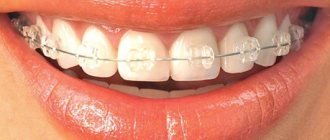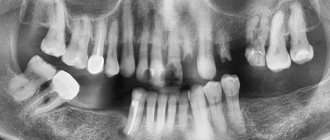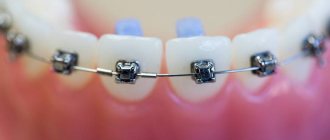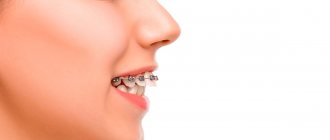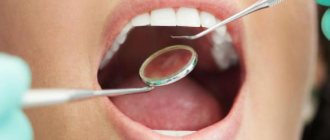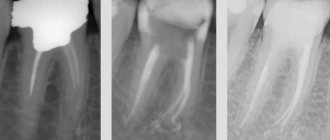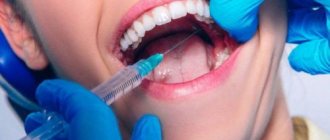Braces in the mouth cause certain inconveniences - not only physiological, but also psychological. It will take time to get used to them. In addition, a person's face may change after wearing braces. True, these changes are rather positive. What happens to the face during bite correction using braces?
In this article
- What consequences can there be from an incorrect bite?
- How to correct a malocclusion
- Mechanism of operation of orthodontic structures
- What happens to the face while wearing braces?
- How does the oval of the face change after braces?
- Do braces change your face forever?
- Oral care while wearing braces
Bite is the arrangement of the teeth of the upper and lower jaw relative to each other in a state of natural full closure. There are four types of correct bite that can be easily determined by your dentist. The teeth may be closed evenly, and the upper or lower teeth may be slightly pushed forward, generally without abnormalities. But there are five types of malocclusions; braces are used to correct them.
With an incorrect bite, the upper or lower jaw may be too forward, or if the jaw is closed, the teeth may be arranged crosswise, like scissors. With an open bite, they do not close completely; a large gap remains between the cutting edges.
Metal braces: pros and cons
Classic metal braces have been used in dentistry for over a hundred years. It is logical to assume that such a significant period indicates many advantages. Let's take a closer look at them.
- Metal braces are reliable and durable, so they are suitable for any clinical cases. They will help correct the most complex malocclusions and crowded teeth.
- The treatment period with metal braces will be shorter than with other systems (this is an important difference between ceramic braces and metal braces). Those patients who want to correct the defect as quickly as possible should choose them.
- Metal braces on teeth are more difficult to damage from hard food, and they are not stained by tea, coffee, wine and carbonated drinks with dyes.
- Finally, this is the most affordable type of orthodontic appliance. Getting metal braces cheaply is not difficult at all.
The disadvantages include the way metal braces look on your teeth. And although manufacturers are constantly improving the appearance of the structure - making smaller clasps and offering self-ligating metal braces without rubber bands or wires, the aesthetics of such systems still leave much to be desired. There is also the possibility of an allergy to the metal of the braces. Despite the use of only safe alloys - titanium, stainless steel, nickel, locks can cause an individual reaction. Before installation, patients prone to allergies must find out what metal the braces of the chosen brand are made of.
FAQ
1. Can there be an allergy to the material of the products? Yes, sometimes there is an allergic reaction to steel structures. In this case, they are replaced with titanium, gold, and platinum.
2. If the lock suddenly comes unglued, how quickly do you need to put it back in place? The sooner the better, since defects negatively affect the effectiveness of the structure (in a few days the tooth can return to its original position).
3. What to do if the structure severely injures the mucous membrane? Orthodontists recommend using a special wax that protects soft tissues from damage.
4. What can cause the arc to break?
From eating hard foods, due to injury, from brushing your teeth too vigorously. Moscow metro station Zvezdnaya, Danube Avenue, 23
Types of metal braces
Based on the place of attachment to the teeth, braces are divided into vestibular and lingual. Another classification is based on the presence or absence of ligatures - auxiliary elements with which the braces are connected to the arch. Ligatures can be in the form of rubber bands or thin wires. There are also mini braces.
- Vestibular structures
are installed on the outer part of the teeth. These are ordinary metal braces that we are all familiar with. Such braces are more universal, correct a defect faster, do not distort diction and require less time to get used to. On the other hand, vestibular systems are visible on the teeth and can damage soft tissue. - Lingual metal braces
are installed on the inside of the teeth, so the brackets are not visible to others. This is an ideal solution for those who want to hide the fact of orthodontic treatment, for example, for public people. True, you will have to prepare for a longer period of bite correction, take longer to get used to the design, and also part with a much more significant amount. - Metal ligature braces
are visually more “heavy” and require frequent (every 3-4 weeks) visits to the orthodontist for correction, since the ligatures quickly stretch. However, some doctors consider such systems more suitable for difficult cases, and the cost of their installation is lower. - Metal non-ligature braces
Instead of ligatures, the systems use special latches or clamps. They do not block the arc, making the friction force minimal, which has a positive effect on comfort and treatment time. Patients with a metal self-ligating brace system can come for corrections half as often, and the procedure itself will last a matter of minutes. However, ligature-free braces are more expensive. - Non-ligature
For more comfortable and aesthetic treatment in orthodontics, special mini-designs have been developed. Their size is 20-30% smaller than standard braces, while the timing and effectiveness of treatment remain the same. This is a more aesthetic alternative to classic metal braces, which also does not require large expenses.
Millions of people around the world have chosen braces as a means of correcting their bite. Many people complain about this aesthetic problem. But how effective is wearing braces? Are there any side effects?
According to the results of recent research in the field of orthodontics, wearing braces leads to serious changes in the oval of the face. This conclusion was reached by two well-known world-class experts - Eric Gibbs from the USA and Mike Mew from the UK. They have been sharing their opinions with patients and the public for over 10 years through publications in scientific journals and speaking engagements. But for most people, braces are still the #1 choice for correcting malocclusion. Next, we'll look at why trying to improve your appearance with braces can backfire.
Shocking facial changes
Experts in the field of orthodontics are reluctant to admit the indisputable fact that braces cause harm to those who use them, although they see the results of this method of bite correction right in front of them every day. When viewing their own photographs taken before and after orthodontic treatment, many patients are horrified and make complaints to the “specialists”. But the latter only shrug their shoulders or even refer the patient to a psychotherapist. The main problem is that patients are not warned about the possible consequences.
Braces can harm not only a person’s appearance, but also their health, including psychological health, since the results obtained often sharply reduce the patient’s self-esteem. This applies to the greatest extent to women who always want to look attractive. Practice shows that braces can change the facial features of even a naturally pretty girl. Natural beauty will not disappear, but the face loses some oval prettiness and looks more mature. It turns out that while wearing braces you can get a serious visual “increase” in age. According to the famous Russian doctor A.O. Savinova, the changed face will look like an “old woman’s face.”
Collecting data on the negative consequences of wearing braces on the shape of the face is the life's work of the American scientist Dr. Gibbs. The research results confirm what is already clear to many - orthodontic braces lengthen the face in the vertical direction. It is also known that the degree of influence on the shape of the face that braces have is related to the direction of facial growth. After wearing braces, people with so-called horizontally developed faces look best.
The main differences between “before” and “after”
The presented photos demonstrate the differences in the location of the upper jaw in the two girls, and how much this affects their appearance. In the first girl, the upper jaw is extended forward, and in the second, it is pulled down. The different structure of the upper jaw is not due to genetic factors, but to environmental influences. The latter, according to Dr. Mew, include the consequences of birth trauma, lack of breastfeeding, eating small amounts of solid food, pacifier or thumb sucking, and orthodontic intervention. The girl on the left is luckier, as her facial structure indicates that she grew up in more favorable conditions for the development of her face. The second girl's face looks elongated due to wearing braces. An increasing number of people are exposing themselves to such unfavorable changes.
The upper jaw, located horizontally and slightly protruded forward, is a distinctive characteristic of the faces of all cartoon characters who are positioned as handsome or beauties. The lines of their cheekbones are usually parallel to the line of the nose. If animators depict a villain, the maxillae of his face are slightly pushed back and pulled down. Similar techniques can be seen in the photo above.
The correct development of teeth is directly related to the direction of growth of the upper jaw. If it is horizontal, then the teeth do not grow as “crowded” as in the case of an elongated face and a vertically positioned upper jaw. These features were noticed and described first by Dr. Zakrisson (Norway) and subsequently by Dr. Woodside. They also noted that people with a vertically elongated face exhibit abnormalities in the development of the mandibular canines.
The development of intraoral devices that promote horizontal facial growth was started by European and American scientists in the last century. In the 80s and 90s, the world saw new devices - ALF and Bioblock, which are used to expand the upper jaw. The results of the studies are completely inconsistent with what orthodontists and dentists are taught. Despite the obvious advantages of the method used in the above-mentioned devices, it still does not receive due attention from official science and is used only in limited circles.
An illustrative example is the story of two twins, whose faces were initially absolutely identical. To treat malocclusion and crowding of teeth, they underwent two different courses of therapy. The first had his crowded teeth removed and then braces installed. The second was treated using the orthotropics method using an intraoral apparatus. A noteworthy fact is that his extra teeth were not removed. The photo shows that the first twin's upper jaw is pushed back and pulled down. This is the result of traditional orthodontic intervention. The second twin's jaw is slightly pushed forward, giving him more attractive facial features.
Reasons for lengthening the face as a result of wearing braces
When looking at photos of popular actresses and models in profile, it will become obvious that their faces have a characteristic feature - an extended upper jaw in the horizontal direction. Wearing braces leads to the opposite result - vertical stretching of the maxillae. This occurs due to many factors, but the main reason is the uniform impact of braces on all teeth of the jaws. The strongest teeth are those with powerful roots, so they take on the greatest force. As a result, there is a narrowing of the dental arches and a horizontal “pulling” of bone tissue. Installing braces does straighten teeth, but does not help achieve the desired result – a beautiful smile. They elongate the midface and make it appear flatter, which is completely inconsistent with the “model-like” look.
Changing the appearance of your face is not the only side effect of wearing straightening braces. As a result of the inward displacement of the upper jaw, the space for the tongue decreases, and snoring occurs during sleep. The best option for getting rid of snoring is to widen the upper jaw and move it forward. It follows that the traditional method of using braces to treat crowded teeth is the cause of unaesthetic elongation of the face and night snoring. A truly effective method is to widen the dental arches.
The girl in the photo did not have her upper canines erupting because there was no room for them in the dentition. Initial treatment involved surgery. But later she decided to turn to orthotropists. After a short course of therapy using the Bioblock device, sufficient space was created for normal canine growth. The girl’s father is a dentist by profession, but even he did not know about orthotropic methods, thanks to which her daughter’s face began to look more expressive and attractive.
Which method is better?
The goal of orthodontic treatment is only to straighten the teeth. But the side effects of such a procedure should force everyone to abandon it. Patients care not only about beautiful teeth, but also attractive facial features in general. Unfortunately, many who choose to wear braces are not even aware of the consequences that await them.
The main distinguishing feature of the orthotropic technique is the alignment of teeth by expanding the dental arches, rather than narrowing them. They use the Bioblock device, which has proven effective in a number of cases. The device straightens crooked teeth and helps to extend the upper jaw horizontally, making facial features more attractive. This method is advisable to use for treating children aged 8 to 12 years.
Correction of the upper jaw in adults is possible using the ALF device. This direction of medicine is called craniodontics (in our country – orthocraniodontics). The device is successfully used even for those patients who wore braces and are not satisfied with the results obtained. Unfortunately, this area of medicine has not yet received due attention in our country, but over time the situation will change, and everyone will have a chance to correct the horrific results of orthodontics.
The article uses photos from the sites claimingpower.com, forum.stom.ru, breket.info
Metal braces from different manufacturers
- Damon Q metal braces
are perhaps the most popular on the market due to their patented design and locking system. The advantages of the Damon brand are reliability and reduced treatment time.
- Victory metal braces
from 3M Unitek are considered one of the most attractive metal solutions. They are distinguished by the anatomical shape of the locks and a special surface that facilitates installation. In addition, 3M metal braces belong to the budget category. - Metal braces “Pilot”
are a domestic development that combines an affordable price and quite a good level of efficiency. There are no innovative technologies here, but the solution copes with its main task. - Metal Marquis braces
from Ortho Technology are also in demand among doctors and patients. They are easy to use and especially hygienic: the clasps are precisely adjusted to the teeth and have a low profile, so they are comfortable to wear, and food residues will practically not get stuck between the elements of the system. At the same time, Marquis metal braces allow you to replace arches in the shortest possible time. - American Orthodontics Empower metal braces
are the flagship products in the orthodontic construction market. They are effective and reliable, as well as aesthetically pleasing due to the small size of the locks. However, the cost of their installation will be higher than many analogues. - Mini Master metal braces
from American Orthodontics are miniature in size (25% smaller than other systems). They are “shrunk” not only in width, but also in thickness, which eliminates injury to soft tissues. Mini Master also gives you the opportunity to wear colored metal braces of your favorite shade.
Reviews from orthodontists
“A proven brace for years that I trust. Working with Damon Q, I know for sure that the work of an orthodontist is an intellectual process, and in implementation I rely on the system, and the technology will definitely not let you down. This is a tool that is easy to work with. The equipment is comfortable for me and for the patient. In the role of the latter, I also know Damon Q.”
“It seemed that Damon Q was perfection, but Damon Q2 appeared and made the possibilities of orthodontists even wider. More accuracy, faster implementation of the information embedded in the bracket. There is a lot of room for imagination: we are happy to combine Damon systems in the oral cavity.”
Dentist-orthodontist, expert on the Insignia system Sigua Nino Valerievna.
The material is for informational purposes only and is presented for informational purposes. It does not replace consultation with an orthodontist and is not a guide to correcting dental anomalies.
Which metal braces are better?
You can choose one or another type of braces only after diagnosis, and also based on the financial capabilities of the patient. A metal ligature braces system would be the best choice if you need to save money, while metal self-ligating braces are suitable for busy people who are short on time. In addition, it is much easier to care for a structure without ligatures.
As for lingual systems, due to their cost and complexity of installation, they are not yet very popular in Russia, and finding a good doctor who specializes in such designs will not be easy. Therefore, based on a combination of factors, vestibular metal self-adjusting braces can be called the optimal solution.
TOP 10 best systems
- Damon
- Alexander
- In-Ovation
- Insignia
- Empower
- Marquis
- Master and Mini Master
- Sprint
- Orthos
- Victory
Important! If you have possible allergic reactions to metals, the following designs are definitely suitable for you: titanium Orthos, as well as nickel-free Quick and Sprint.
When compiling this rating, we took into account efficiency, price, prevalence in the Russian market, degree of fixation on the teeth (use of a mesh or porous base to use more adhesive glue), and the presence of low-profile and highly polished plates.
Next, we’ll look at why exactly these bracket systems were included in the rating of the best.
Installation of metal braces
In order to get metal braces, you need to go through three main stages.
- Diagnostic.
This includes: consultation with an orthodontist, medical history, radiography, orthopantomography, photographs of the patient from different angles, drawing up a treatment plan and choosing the appropriate brace system. - Sanitation of the oral cavity.
Treatment of caries and other diseases, elimination of foci of inflammation, if necessary, extraction of teeth or prosthetics, removal of hard deposits and plaque, strengthening of enamel. - Direct installation of a metal bracket system.
The last stage lasts no more than two hours. The doctor prepares the surface of the teeth, glues a separate lock-bracket to each tooth one by one, and fixes the adhesive solution with an ultraviolet lamp. If the locks are installed using the indirect method, that is, all at once, the procedure time is halved. He then connects the clasps to the archwire using ligatures or built-in fasteners. At the end, additional elements are installed - rings, cheek locks, hooks for elastic rods, springs, and so on.
In rare cases, metal braces are placed on one jaw. This is possible with slight curvature of the teeth, which does not affect the bite in any way.
How is treatment with metal braces performed?
Fixed orthodontic appliances apply constant pressure to the teeth, causing them to gradually move into the desired position. The arch plays a significant role in this process: at first it repeats the irregular shape of the teeth, but tends to return to its original position, thanks to which it smoothly corrects the bite. After each correction, the doctor changes the archwire to a thicker one to increase the pressure.
Let's look at why metal braces straighten teeth faster. The main quality of a metal system is its strength, and it does not really matter what metal is used in the braces. Due to the force of pressure, the teeth move faster and the treatment period is reduced. If the patient is faced with a choice between sapphire or metal braces, he must understand: although the sapphire design looks attractive, it will take a little longer to wear due to the fragility of the material.
So how long do you wear metal braces? Orthodontists call the average treatment period 1.5 - 2 years, but everything, of course, depends on the clinical case. The minimum period is 1 year for mild crowding of teeth, the maximum is about 3 years.
Hygiene rules and nutritional features
An integral part of orthodontic treatment with braces is constant monitoring of the condition of the oral cavity. After installing the system, if you experience discomfort or pain from rubbing, you should immediately contact your orthodontist. He will correct the design, apply special food-grade wax to the areas of braces that injure the gums, and prescribe medications for the treatment of inflammatory processes in the oral mucosa.
It is very important to develop good eating habits:
- do not eat solid food;
- healthy vegetables and fruits - only grated or cut into pieces, but in no case whole;
- exclude everything crispy and sticky (crackers, toffee, chewing gum, caramel, etc.);
- avoid sweets and soda to protect tooth enamel;
- Avoid very hot and cold drinks—temperature changes can cause braces to come off your teeth;
Anyone who wears braces is recommended to brush their teeth every time after eating, most thoroughly before going to bed. It is necessary to use tools such as:
- orthodontic brushes (with a small compact head and a V-shaped recess in the middle) for high-quality and gentle cleansing;
- dental floss (preferably orthodontic);
- an irrigator that will help remove food debris, plaque, and also prevent bleeding by massaging the gums;
- brush-brush for cleaning locks and removing stuck food in braces;
- restorative mousses with minerals.
It is recommended to visit a hygienist for professional teeth cleaning approximately once 3 months.
What is the difference between ceramic braces and metal braces?
Many patients are interested in what is better - ceramic or metal braces. You need to understand that both types of systems cope well with their task, the only question is in the details.
When choosing ceramic or metal braces, you should decide on your priorities: aesthetics or treatment time? Ceramic systems are practically invisible on the teeth, and this makes the correction psychologically more comfortable. On the other hand, if it takes a year and a half to correct a moderate defect with metal braces, then with ceramic braces it will take about two years.
Lifestyle will help you understand which braces are better - ceramic or metal. Metal is much less capricious: it does not stain under the influence of red wine, tea and coffee, and is also not prone to chips and cracks.
Another popular question is whether it is possible to smoke with metal braces. If we do not take into account the harm from smoking as such, then it is really better for smokers to install a metal system, since ceramics can change color under the influence of resins.
Mechanism of operation of orthodontic structures
Each bracket is fixed to the crown and rotated in the desired plane to rotate and correct the position of the tooth in the row. Braces are made according to an impression of the patient’s jaw, taking into account all individual characteristics. Metal arches put pressure on the crowns, the periodontal ligaments are stretched, and the tooth gradually moves to the desired position. As it moves, the bone tissue is absorbed, and a new one is formed in the previous area.
In addition, other facial structures also change, since they are all connected together. This is why wearing braces inevitably changes the shape of your face.
Combined braces: metal and ceramic
To save on installing an aesthetic system, you can choose combined metal and ceramic braces. When a person smiles, the lower teeth are less visible, so to save money it is worth putting metal braces on the lower jaw and ceramic braces on the upper jaw. This is a worthy compromise between the cost of treatment and psychological comfort during it. Similarly, you can combine sapphire with metal.
Is it possible to get metal braces inexpensively?
Undoubtedly. Installing regular staples is the cheapest. However, the price of metal braces can vary. Designs with ligatures will cost the least - from 25,000 rubles, a metal non-ligature bracket system starts at 35,000 rubles. Of course, we are talking about vestibular structures, since the price list for lingual systems starts from 100,000 rubles. Ceramic braces with a metal groove will be an order of magnitude more expensive than a conventional system. You also need to keep in mind that metal braces for the upper jaw are more expensive than for the lower jaw. Such designs are the most affordable, and this is also the difference between metal and ceramic braces. The table below will help you navigate the cost of metal structures, as well as a call to a clinic where you can install braces in Moscow.
| Bracket systems | Price |
| Vestibular | from 50,000 rubles |
| Lingual | from 100,000 rubles |
| Mini | from 30,000 rubles |
| Ligature | from 25,000 rubles |
| Unligated | from 35,000 rubles |
